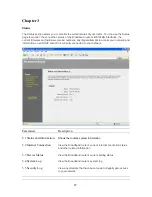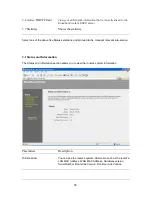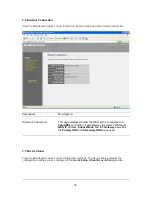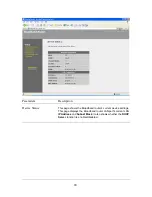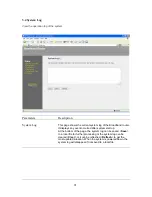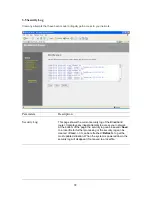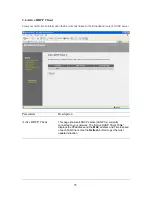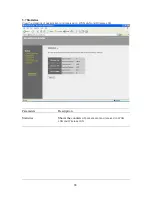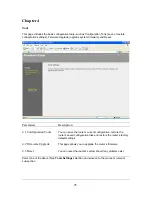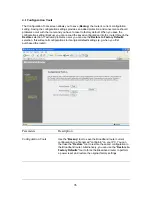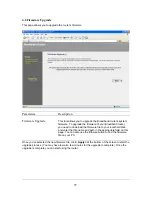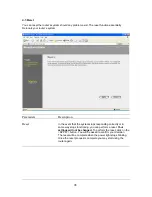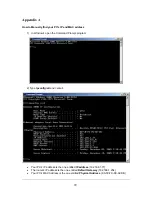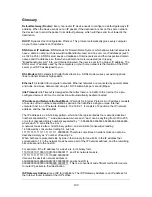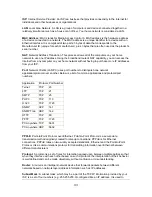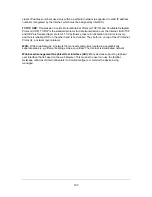
100
Glossary
Default Gateway (Router):
Every non-router IP device needs to configure a default gateway’s IP
address. When the device sends out an IP packet, if the destination is not on the same network,
the device has to send the packet to its default gateway, which will then send it out towards the
destination.
DHCP:
Dynamic Host Configuration Protocol. This protocol automatically gives every computer
on your home network an IP address.
DNS Server IP Address:
DNS stands for Domain Name System, which allows Internet servers to
have a domain name (such as www.Broadbandrouter.com) and one or more IP addresses (such
as 192.34.45.8). A DNS server keeps a database of Internet servers and their respective domain
names and IP addresses, so that when a domain name is requested (as in typing
"Broadbandrouter.com" into your Internet browser), the user is sent to the proper IP address. The
DNS server IP address used by the computers on your home network is the location of the DNS
server your ISP has assigned to you.
DSL Modem:
DSL stands for Digital Subscriber Line. A DSL modem uses your existing phone
lines to transmit data at high speeds.
Ethernet:
A standard for computer networks. Ethernet networks are connected by special cables
and hubs, and move data around at up to 10/100 million bits per second (Mbps).
Idle Timeout:
Idle Timeout is designed so that after there is no traffic to the Internet for a pre-
configured amount of time, the connection will automatically be disconnected.
IP Address and Network (Subnet) Mask:
IP stands for Internet Protocol. An IP address consists
of a series of four numbers separated by periods, that identifies a single, unique Internet
computer host in an IP network. Example: 192.168.2.1. It consists of 2 portions: the IP network
address, and the host identifier.
The IP address is a 32-bit binary pattern, which can be represented as four cascaded decimal
numbers separated by “.”: aaa.aaa.aaa.aaa, where each “aaa” can be anything from 000 to 255,
or as four cascaded binary numbers separated by “.”: bbbbbbbb.bbbbbbbb.bbbbbbbb.bbbbbbbb,
where each “b” can either be 0 or 1.
A network mask is also a 32-bit binary pattern, and consists of consecutive leading
1’s followed by consecutive trailing 0’s, such as
11111111.11111111.11111111.00000000. Therefore sometimes a network mask can also be
described simply as “x” number of leading 1’s.
When both are represented side by side in their binary forms, all bits in the IP address that
correspond to 1’s in the network mask become part of the IP network address, and the remaining
bits correspond to the host ID.
For example, if the IP address for a device is, in its binary form,
11011001.10110000.10010000.00000111, and if its network mask is,
11111111.11111111.11110000.00000000
It means the device’s network address is
11011001.10110000.10010000.00000000, and its host ID is,
00000000.00000000.00000000.00000111. This is a convenient and efficient method for routers
to route IP packets to their destination.
ISP Gateway Address:
(see ISP for definition). The ISP Gateway Address is an IP address for
the Internet router located at the ISP's office.
Содержание 521666
Страница 1: ...1 Wireless Broadband Router 521666 Manual ...
Страница 7: ...7 Setup Diagram Figure 1 2 below shows a typical setup for a Local Area Network LAN Figure 1 2 ...
Страница 43: ...43 Station Ad Hoc mode setting page ...
Страница 44: ...44 Station Infrastructure mode setting page ...
Страница 45: ...45 AP Bridge Point to Point mode setting page ...
Страница 46: ...46 AP Bridge Point to Multi Point mode setting page ...
Страница 83: ...83 You can now configure other advance sections or start using the router with the advance settings in place ...


